Accounting Report: ASIC Role, Wesfarmers Impairment and Compliance
VerifiedAdded on 2021/05/31
|11
|1795
|121
Report
AI Summary
This report provides a comprehensive analysis of impairment write-downs, focusing on Wesfarmers Limited, a prominent company in the Australian retail industry. It begins by examining the role of the Australian Securities and Investment Commission (ASIC) as a corporate regulator, highlighting its responsibilities in promoting market confidence, ensuring market efficiency, and improving financial reporting quality. The report then delves into the specifics of impairment write-downs within Wesfarmers, including the assets tested, such as property, plant, and equipment (PPE), trade receivables, and goodwill, along with the amounts of impairment losses. It then assesses Wesfarmers' compliance with the qualitative characteristics of financial information, specifically relevance, faithful representation, and timeliness, as outlined in AASB 136. Finally, the report evaluates Wesfarmers' adherence to the objectives of general purpose financial reporting, focusing on the recognition of impairment losses and the estimation of cash flows. The report concludes with recommendations for Wesfarmers to enhance its impairment accounting practices, such as emphasizing foreign currency cash flow and considering market capitalization.

Running head: ACCOUNTING
Accounting
Name of the Student
Name of the University
Author’s Note
Accounting
Name of the Student
Name of the University
Author’s Note
Paraphrase This Document
Need a fresh take? Get an instant paraphrase of this document with our AI Paraphraser
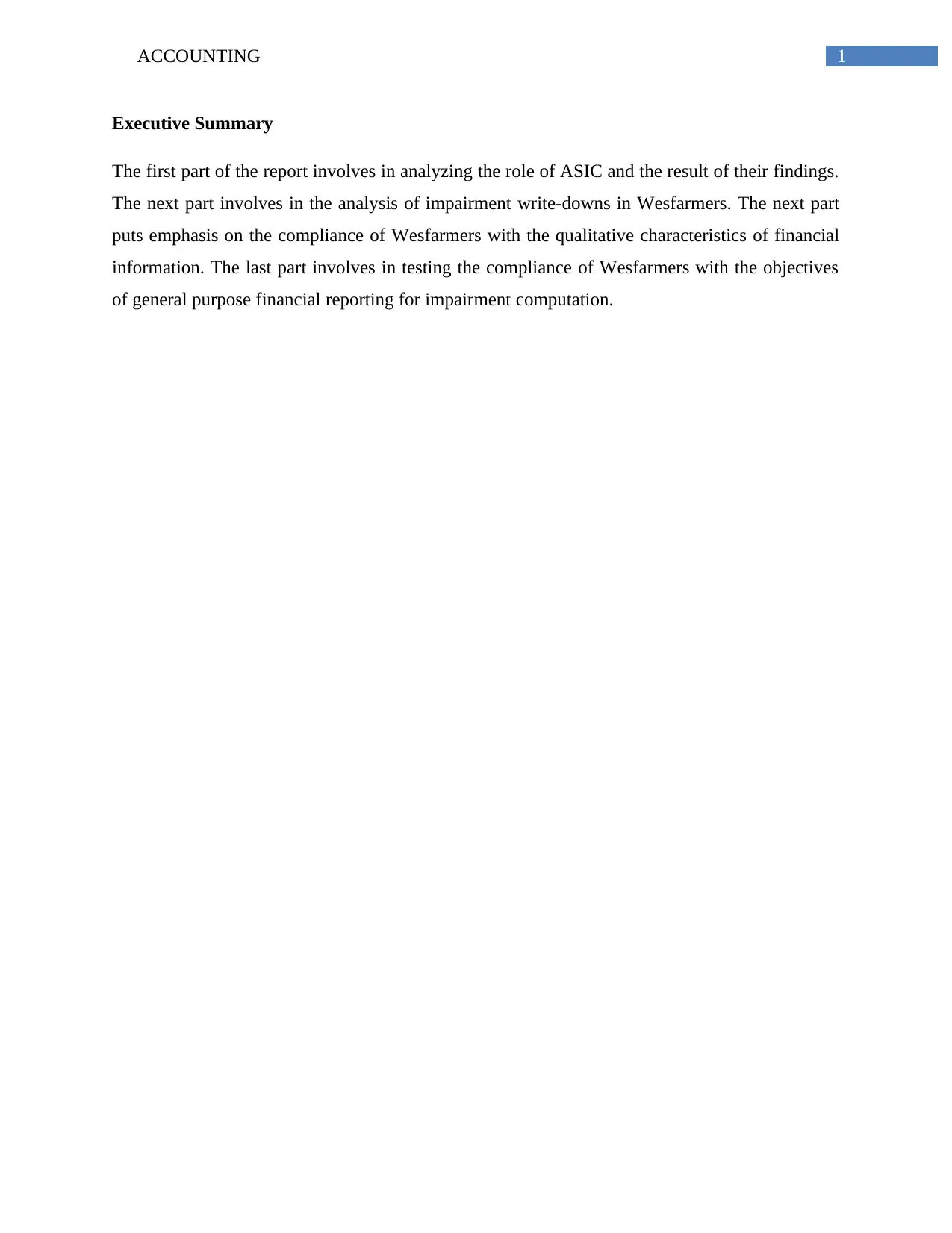
1ACCOUNTING
Executive Summary
The first part of the report involves in analyzing the role of ASIC and the result of their findings.
The next part involves in the analysis of impairment write-downs in Wesfarmers. The next part
puts emphasis on the compliance of Wesfarmers with the qualitative characteristics of financial
information. The last part involves in testing the compliance of Wesfarmers with the objectives
of general purpose financial reporting for impairment computation.
Executive Summary
The first part of the report involves in analyzing the role of ASIC and the result of their findings.
The next part involves in the analysis of impairment write-downs in Wesfarmers. The next part
puts emphasis on the compliance of Wesfarmers with the qualitative characteristics of financial
information. The last part involves in testing the compliance of Wesfarmers with the objectives
of general purpose financial reporting for impairment computation.
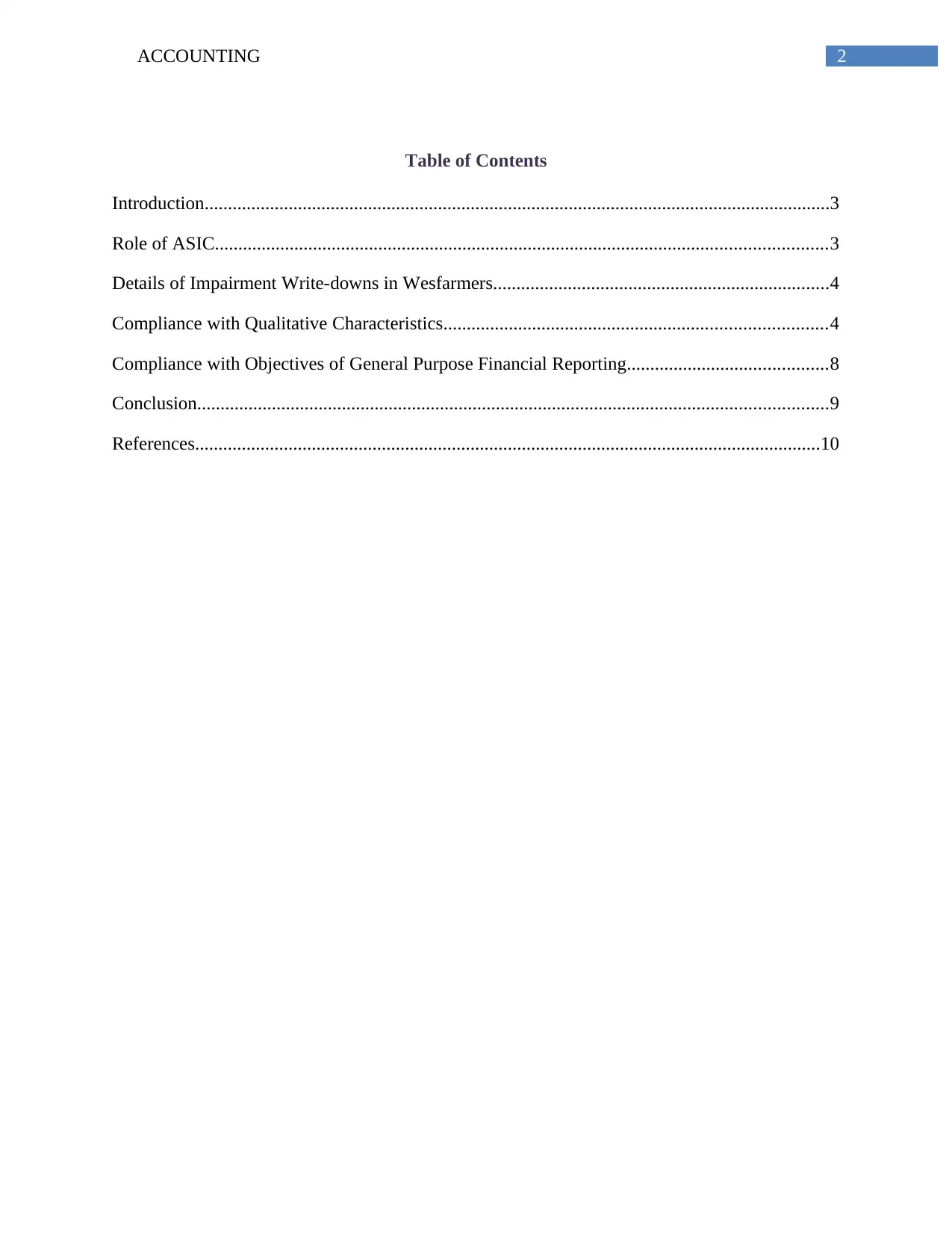
2ACCOUNTING
Table of Contents
Introduction......................................................................................................................................3
Role of ASIC...................................................................................................................................3
Details of Impairment Write-downs in Wesfarmers........................................................................4
Compliance with Qualitative Characteristics..................................................................................4
Compliance with Objectives of General Purpose Financial Reporting...........................................8
Conclusion.......................................................................................................................................9
References......................................................................................................................................10
Table of Contents
Introduction......................................................................................................................................3
Role of ASIC...................................................................................................................................3
Details of Impairment Write-downs in Wesfarmers........................................................................4
Compliance with Qualitative Characteristics..................................................................................4
Compliance with Objectives of General Purpose Financial Reporting...........................................8
Conclusion.......................................................................................................................................9
References......................................................................................................................................10
⊘ This is a preview!⊘
Do you want full access?
Subscribe today to unlock all pages.

Trusted by 1+ million students worldwide
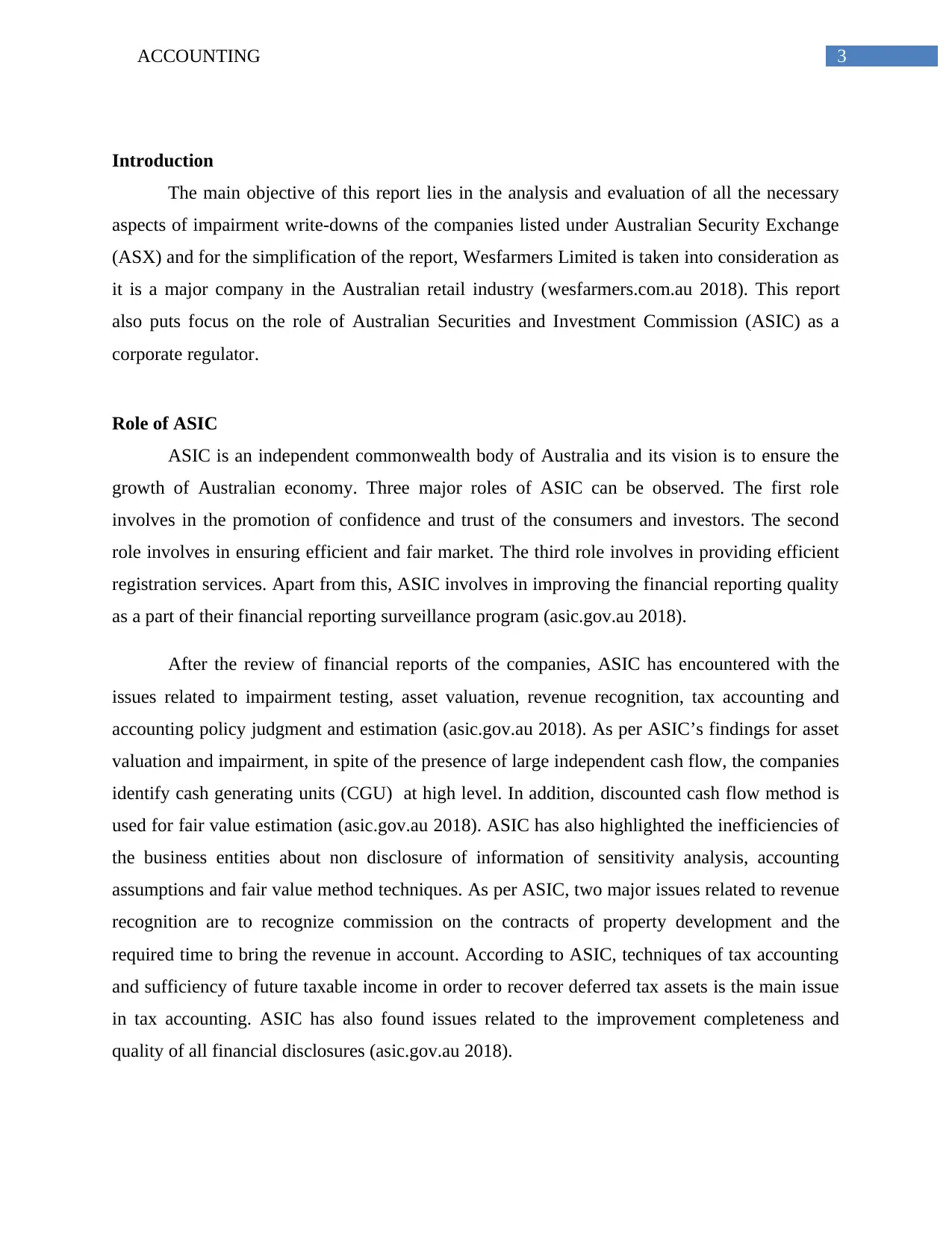
3ACCOUNTING
Introduction
The main objective of this report lies in the analysis and evaluation of all the necessary
aspects of impairment write-downs of the companies listed under Australian Security Exchange
(ASX) and for the simplification of the report, Wesfarmers Limited is taken into consideration as
it is a major company in the Australian retail industry (wesfarmers.com.au 2018). This report
also puts focus on the role of Australian Securities and Investment Commission (ASIC) as a
corporate regulator.
Role of ASIC
ASIC is an independent commonwealth body of Australia and its vision is to ensure the
growth of Australian economy. Three major roles of ASIC can be observed. The first role
involves in the promotion of confidence and trust of the consumers and investors. The second
role involves in ensuring efficient and fair market. The third role involves in providing efficient
registration services. Apart from this, ASIC involves in improving the financial reporting quality
as a part of their financial reporting surveillance program (asic.gov.au 2018).
After the review of financial reports of the companies, ASIC has encountered with the
issues related to impairment testing, asset valuation, revenue recognition, tax accounting and
accounting policy judgment and estimation (asic.gov.au 2018). As per ASIC’s findings for asset
valuation and impairment, in spite of the presence of large independent cash flow, the companies
identify cash generating units (CGU) at high level. In addition, discounted cash flow method is
used for fair value estimation (asic.gov.au 2018). ASIC has also highlighted the inefficiencies of
the business entities about non disclosure of information of sensitivity analysis, accounting
assumptions and fair value method techniques. As per ASIC, two major issues related to revenue
recognition are to recognize commission on the contracts of property development and the
required time to bring the revenue in account. According to ASIC, techniques of tax accounting
and sufficiency of future taxable income in order to recover deferred tax assets is the main issue
in tax accounting. ASIC has also found issues related to the improvement completeness and
quality of all financial disclosures (asic.gov.au 2018).
Introduction
The main objective of this report lies in the analysis and evaluation of all the necessary
aspects of impairment write-downs of the companies listed under Australian Security Exchange
(ASX) and for the simplification of the report, Wesfarmers Limited is taken into consideration as
it is a major company in the Australian retail industry (wesfarmers.com.au 2018). This report
also puts focus on the role of Australian Securities and Investment Commission (ASIC) as a
corporate regulator.
Role of ASIC
ASIC is an independent commonwealth body of Australia and its vision is to ensure the
growth of Australian economy. Three major roles of ASIC can be observed. The first role
involves in the promotion of confidence and trust of the consumers and investors. The second
role involves in ensuring efficient and fair market. The third role involves in providing efficient
registration services. Apart from this, ASIC involves in improving the financial reporting quality
as a part of their financial reporting surveillance program (asic.gov.au 2018).
After the review of financial reports of the companies, ASIC has encountered with the
issues related to impairment testing, asset valuation, revenue recognition, tax accounting and
accounting policy judgment and estimation (asic.gov.au 2018). As per ASIC’s findings for asset
valuation and impairment, in spite of the presence of large independent cash flow, the companies
identify cash generating units (CGU) at high level. In addition, discounted cash flow method is
used for fair value estimation (asic.gov.au 2018). ASIC has also highlighted the inefficiencies of
the business entities about non disclosure of information of sensitivity analysis, accounting
assumptions and fair value method techniques. As per ASIC, two major issues related to revenue
recognition are to recognize commission on the contracts of property development and the
required time to bring the revenue in account. According to ASIC, techniques of tax accounting
and sufficiency of future taxable income in order to recover deferred tax assets is the main issue
in tax accounting. ASIC has also found issues related to the improvement completeness and
quality of all financial disclosures (asic.gov.au 2018).
Paraphrase This Document
Need a fresh take? Get an instant paraphrase of this document with our AI Paraphraser
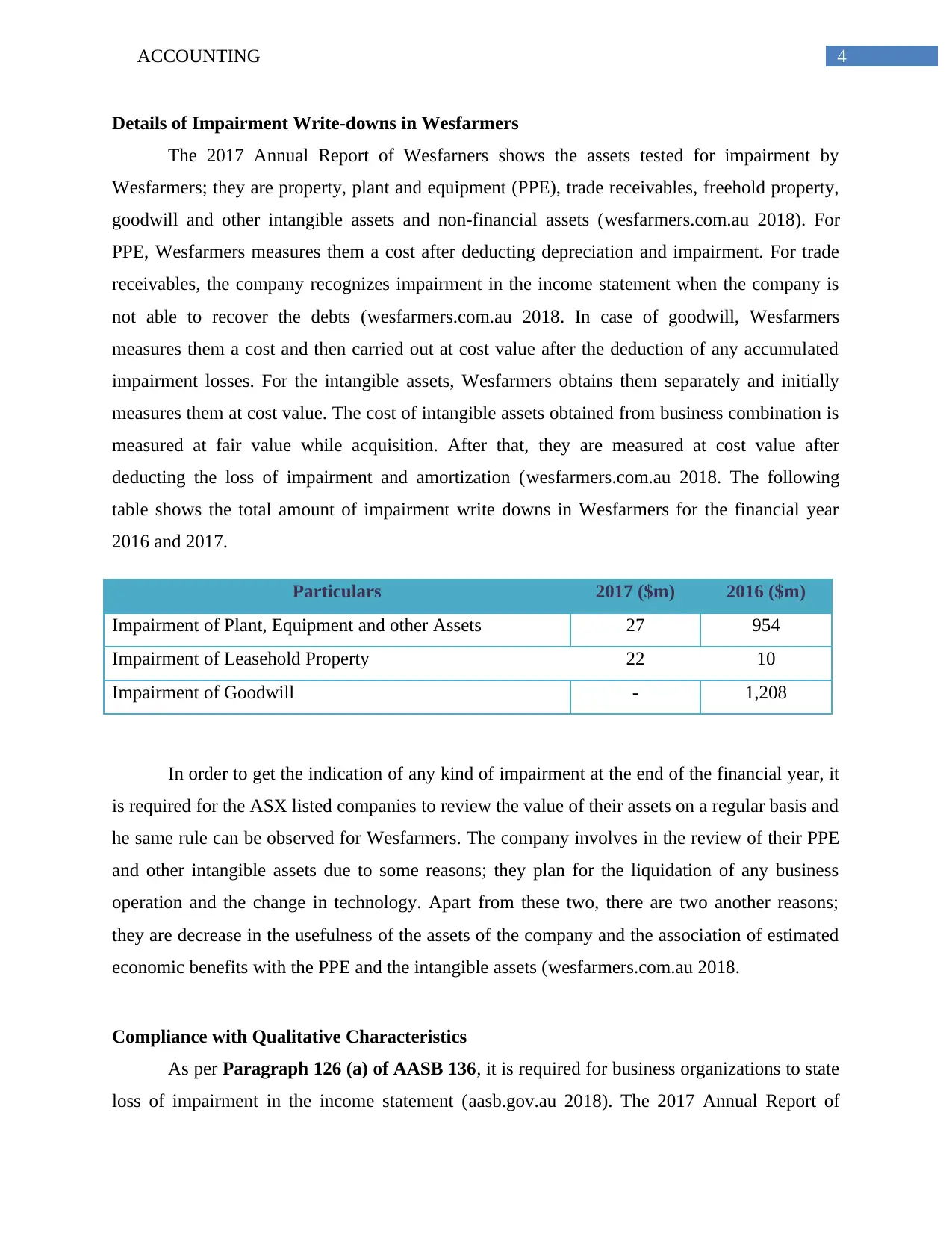
4ACCOUNTING
Details of Impairment Write-downs in Wesfarmers
The 2017 Annual Report of Wesfarners shows the assets tested for impairment by
Wesfarmers; they are property, plant and equipment (PPE), trade receivables, freehold property,
goodwill and other intangible assets and non-financial assets (wesfarmers.com.au 2018). For
PPE, Wesfarmers measures them a cost after deducting depreciation and impairment. For trade
receivables, the company recognizes impairment in the income statement when the company is
not able to recover the debts (wesfarmers.com.au 2018. In case of goodwill, Wesfarmers
measures them a cost and then carried out at cost value after the deduction of any accumulated
impairment losses. For the intangible assets, Wesfarmers obtains them separately and initially
measures them at cost value. The cost of intangible assets obtained from business combination is
measured at fair value while acquisition. After that, they are measured at cost value after
deducting the loss of impairment and amortization (wesfarmers.com.au 2018. The following
table shows the total amount of impairment write downs in Wesfarmers for the financial year
2016 and 2017.
Particulars 2017 ($m) 2016 ($m)
Impairment of Plant, Equipment and other Assets 27 954
Impairment of Leasehold Property 22 10
Impairment of Goodwill - 1,208
In order to get the indication of any kind of impairment at the end of the financial year, it
is required for the ASX listed companies to review the value of their assets on a regular basis and
he same rule can be observed for Wesfarmers. The company involves in the review of their PPE
and other intangible assets due to some reasons; they plan for the liquidation of any business
operation and the change in technology. Apart from these two, there are two another reasons;
they are decrease in the usefulness of the assets of the company and the association of estimated
economic benefits with the PPE and the intangible assets (wesfarmers.com.au 2018.
Compliance with Qualitative Characteristics
As per Paragraph 126 (a) of AASB 136, it is required for business organizations to state
loss of impairment in the income statement (aasb.gov.au 2018). The 2017 Annual Report of
Details of Impairment Write-downs in Wesfarmers
The 2017 Annual Report of Wesfarners shows the assets tested for impairment by
Wesfarmers; they are property, plant and equipment (PPE), trade receivables, freehold property,
goodwill and other intangible assets and non-financial assets (wesfarmers.com.au 2018). For
PPE, Wesfarmers measures them a cost after deducting depreciation and impairment. For trade
receivables, the company recognizes impairment in the income statement when the company is
not able to recover the debts (wesfarmers.com.au 2018. In case of goodwill, Wesfarmers
measures them a cost and then carried out at cost value after the deduction of any accumulated
impairment losses. For the intangible assets, Wesfarmers obtains them separately and initially
measures them at cost value. The cost of intangible assets obtained from business combination is
measured at fair value while acquisition. After that, they are measured at cost value after
deducting the loss of impairment and amortization (wesfarmers.com.au 2018. The following
table shows the total amount of impairment write downs in Wesfarmers for the financial year
2016 and 2017.
Particulars 2017 ($m) 2016 ($m)
Impairment of Plant, Equipment and other Assets 27 954
Impairment of Leasehold Property 22 10
Impairment of Goodwill - 1,208
In order to get the indication of any kind of impairment at the end of the financial year, it
is required for the ASX listed companies to review the value of their assets on a regular basis and
he same rule can be observed for Wesfarmers. The company involves in the review of their PPE
and other intangible assets due to some reasons; they plan for the liquidation of any business
operation and the change in technology. Apart from these two, there are two another reasons;
they are decrease in the usefulness of the assets of the company and the association of estimated
economic benefits with the PPE and the intangible assets (wesfarmers.com.au 2018.
Compliance with Qualitative Characteristics
As per Paragraph 126 (a) of AASB 136, it is required for business organizations to state
loss of impairment in the income statement (aasb.gov.au 2018). The 2017 Annual Report of

5ACCOUNTING
Wesfarmers shows that the company has disclosed their impairment loss in the income statement
and it can be seen as below:
(Sources: wesfarmers.com.au 2018)
As per Paragraph 126 (b) of AASB 136, the requirement for the businesses is the
disclosure of amount of reversal realized in the income statement (aasb.gov.au 2018). For the
reversal of impairment, Wesfarmers uses to determine that whether there is any change in the
used estimates for the determination of amounts recoverable after the last impairment test
(wesfarmers.com.au 2018. As per 2017 Annual Report, Wesfarmers does not have any reversal
of impairment in 2017 and it can be seen as below:
Wesfarmers shows that the company has disclosed their impairment loss in the income statement
and it can be seen as below:
(Sources: wesfarmers.com.au 2018)
As per Paragraph 126 (b) of AASB 136, the requirement for the businesses is the
disclosure of amount of reversal realized in the income statement (aasb.gov.au 2018). For the
reversal of impairment, Wesfarmers uses to determine that whether there is any change in the
used estimates for the determination of amounts recoverable after the last impairment test
(wesfarmers.com.au 2018. As per 2017 Annual Report, Wesfarmers does not have any reversal
of impairment in 2017 and it can be seen as below:
⊘ This is a preview!⊘
Do you want full access?
Subscribe today to unlock all pages.

Trusted by 1+ million students worldwide
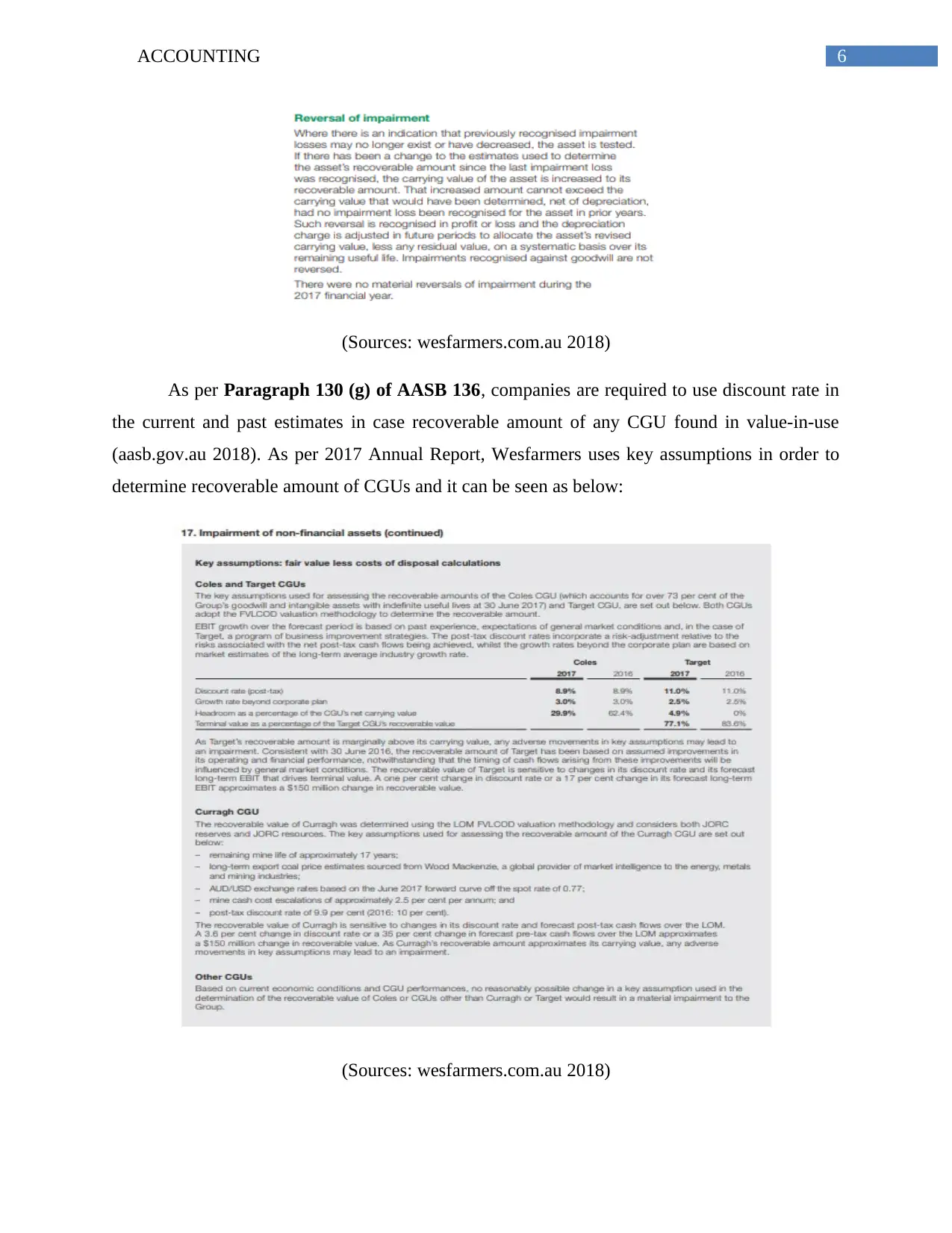
6ACCOUNTING
(Sources: wesfarmers.com.au 2018)
As per Paragraph 130 (g) of AASB 136, companies are required to use discount rate in
the current and past estimates in case recoverable amount of any CGU found in value-in-use
(aasb.gov.au 2018). As per 2017 Annual Report, Wesfarmers uses key assumptions in order to
determine recoverable amount of CGUs and it can be seen as below:
(Sources: wesfarmers.com.au 2018)
(Sources: wesfarmers.com.au 2018)
As per Paragraph 130 (g) of AASB 136, companies are required to use discount rate in
the current and past estimates in case recoverable amount of any CGU found in value-in-use
(aasb.gov.au 2018). As per 2017 Annual Report, Wesfarmers uses key assumptions in order to
determine recoverable amount of CGUs and it can be seen as below:
(Sources: wesfarmers.com.au 2018)
Paraphrase This Document
Need a fresh take? Get an instant paraphrase of this document with our AI Paraphraser

7ACCOUNTING
As per AASB 136, companies are required to allocate goodwill in the CGUs to get the
benefits (aasb.gov.au 2018). As per 2017 Annual Report, Wesfarmers has made the allocation of
goodwill in CGUs and it can be seen as below:
(Sources: wesfarmers.com.au 2018)
The fundamental qualitative characteristics of financial information are Relevance and
Faithful Representation; and one enhancing qualitative characteristic is timeliness (aasb.gov.au
2018). From the above discussion, it can be observed that Wesfarmers has represented all the
relevant information of impairment on faithful basis after complying with the standards of AASB
136. In addition, all the relevant information are timely disclosed in the 2017 Annual Report.
As per AASB 136, companies are required to allocate goodwill in the CGUs to get the
benefits (aasb.gov.au 2018). As per 2017 Annual Report, Wesfarmers has made the allocation of
goodwill in CGUs and it can be seen as below:
(Sources: wesfarmers.com.au 2018)
The fundamental qualitative characteristics of financial information are Relevance and
Faithful Representation; and one enhancing qualitative characteristic is timeliness (aasb.gov.au
2018). From the above discussion, it can be observed that Wesfarmers has represented all the
relevant information of impairment on faithful basis after complying with the standards of AASB
136. In addition, all the relevant information are timely disclosed in the 2017 Annual Report.

8ACCOUNTING
Compliance with Objectives of General Purpose Financial Reporting
General purpose financial reporting helps in the delivery of financial information to the
capital investors to assist in decision-making process. As per Paragraph 70 of the Conceptual
Framework, companies are required to recognize impairment loss when carrying amount is not
recoverable (aasb.gov.au 2018). As per 2017 Annual Report, Wesfarmers recognizes impairment
loss in case carrying amount of greater than recoverable amount and it can be seen as below:
(Sources: wesfarmers.com.au 2018)
As per Paragraph 130 of the Conceptual Framework, for the asset impairment test
under AASB 136, companies are required to estimate the cash flow from the market perspective
rather than the company perspective (aasb.gov.au 2018). As per 2017 Annual Report, there is not
any generation of cash flow in Wesfarmers and the company cannot project value-in-use as per
the fair value. It can be seen as below:
(Sources: wesfarmers.com.au 2018)
Thus, from the above discussion, it can be observed that Wesfarmers has complied with
all the objectives of general purpose financial reporting for the disclosure of impairment details.
Compliance with Objectives of General Purpose Financial Reporting
General purpose financial reporting helps in the delivery of financial information to the
capital investors to assist in decision-making process. As per Paragraph 70 of the Conceptual
Framework, companies are required to recognize impairment loss when carrying amount is not
recoverable (aasb.gov.au 2018). As per 2017 Annual Report, Wesfarmers recognizes impairment
loss in case carrying amount of greater than recoverable amount and it can be seen as below:
(Sources: wesfarmers.com.au 2018)
As per Paragraph 130 of the Conceptual Framework, for the asset impairment test
under AASB 136, companies are required to estimate the cash flow from the market perspective
rather than the company perspective (aasb.gov.au 2018). As per 2017 Annual Report, there is not
any generation of cash flow in Wesfarmers and the company cannot project value-in-use as per
the fair value. It can be seen as below:
(Sources: wesfarmers.com.au 2018)
Thus, from the above discussion, it can be observed that Wesfarmers has complied with
all the objectives of general purpose financial reporting for the disclosure of impairment details.
⊘ This is a preview!⊘
Do you want full access?
Subscribe today to unlock all pages.

Trusted by 1+ million students worldwide

9ACCOUNTING
Conclusion
Based on the above discussion, it can be observed that Wesfarmers follows all the
requirement of AASB 136 for the asset impairment accounting that satisfies the fundamental as
well as enhancing characteristics of financial information. IN addition, Wesfarmers also
complies with the objectives of general purpose financial reporting for asset impairment.
Some recommendations are provided below:
Wesfarmers is needed to put emphasis on foreign currency cash flow.
The company is required to contrast the impairment data with the external data.
Wesfarmers is required to consider market capitalization while computing asset
impairment.
The company is needed to scrutiny the discount rate effectively.
Conclusion
Based on the above discussion, it can be observed that Wesfarmers follows all the
requirement of AASB 136 for the asset impairment accounting that satisfies the fundamental as
well as enhancing characteristics of financial information. IN addition, Wesfarmers also
complies with the objectives of general purpose financial reporting for asset impairment.
Some recommendations are provided below:
Wesfarmers is needed to put emphasis on foreign currency cash flow.
The company is required to contrast the impairment data with the external data.
Wesfarmers is required to consider market capitalization while computing asset
impairment.
The company is needed to scrutiny the discount rate effectively.
Paraphrase This Document
Need a fresh take? Get an instant paraphrase of this document with our AI Paraphraser
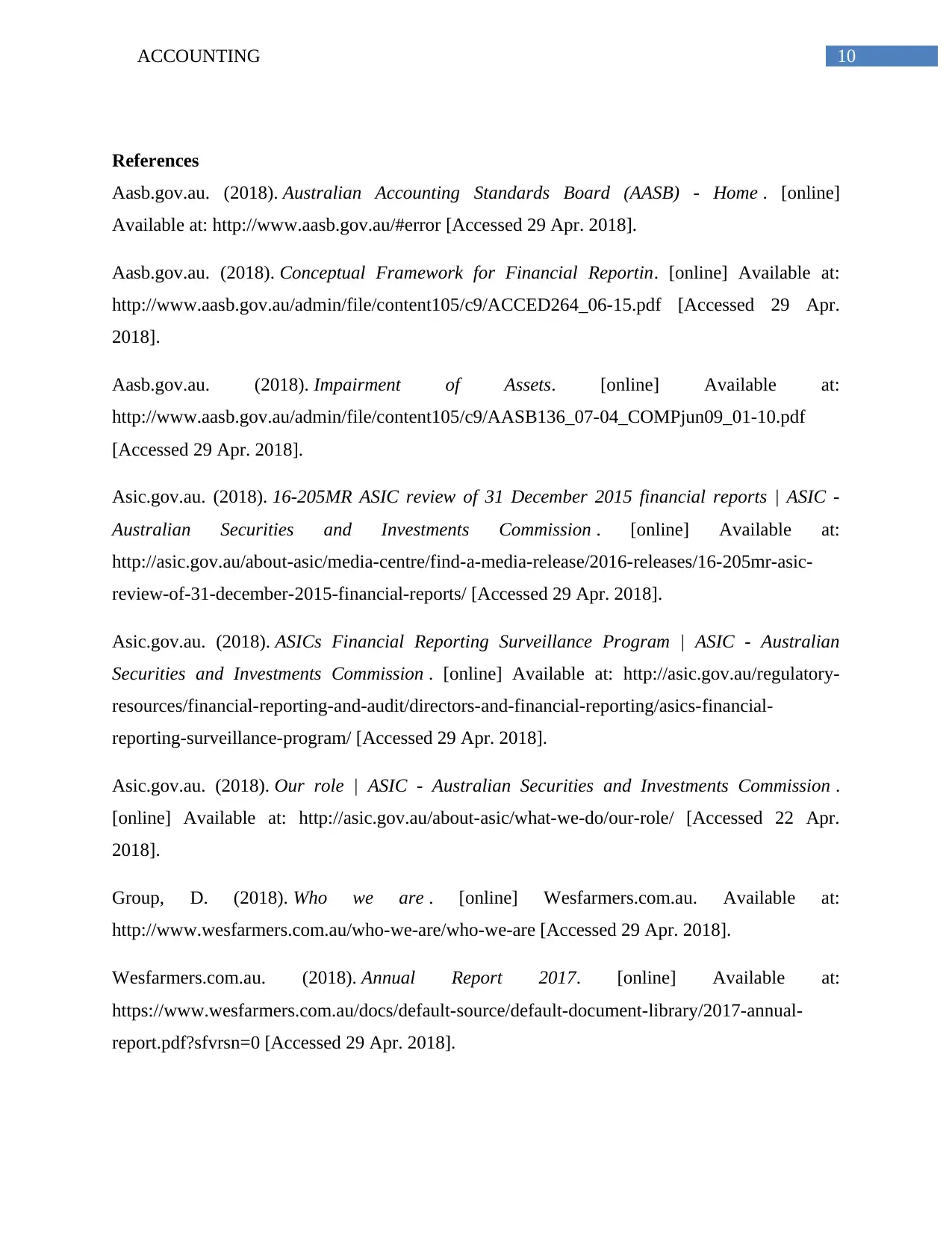
10ACCOUNTING
References
Aasb.gov.au. (2018). Australian Accounting Standards Board (AASB) - Home . [online]
Available at: http://www.aasb.gov.au/#error [Accessed 29 Apr. 2018].
Aasb.gov.au. (2018). Conceptual Framework for Financial Reportin. [online] Available at:
http://www.aasb.gov.au/admin/file/content105/c9/ACCED264_06-15.pdf [Accessed 29 Apr.
2018].
Aasb.gov.au. (2018). Impairment of Assets. [online] Available at:
http://www.aasb.gov.au/admin/file/content105/c9/AASB136_07-04_COMPjun09_01-10.pdf
[Accessed 29 Apr. 2018].
Asic.gov.au. (2018). 16-205MR ASIC review of 31 December 2015 financial reports | ASIC -
Australian Securities and Investments Commission . [online] Available at:
http://asic.gov.au/about-asic/media-centre/find-a-media-release/2016-releases/16-205mr-asic-
review-of-31-december-2015-financial-reports/ [Accessed 29 Apr. 2018].
Asic.gov.au. (2018). ASICs Financial Reporting Surveillance Program | ASIC - Australian
Securities and Investments Commission . [online] Available at: http://asic.gov.au/regulatory-
resources/financial-reporting-and-audit/directors-and-financial-reporting/asics-financial-
reporting-surveillance-program/ [Accessed 29 Apr. 2018].
Asic.gov.au. (2018). Our role | ASIC - Australian Securities and Investments Commission .
[online] Available at: http://asic.gov.au/about-asic/what-we-do/our-role/ [Accessed 22 Apr.
2018].
Group, D. (2018). Who we are . [online] Wesfarmers.com.au. Available at:
http://www.wesfarmers.com.au/who-we-are/who-we-are [Accessed 29 Apr. 2018].
Wesfarmers.com.au. (2018). Annual Report 2017. [online] Available at:
https://www.wesfarmers.com.au/docs/default-source/default-document-library/2017-annual-
report.pdf?sfvrsn=0 [Accessed 29 Apr. 2018].
References
Aasb.gov.au. (2018). Australian Accounting Standards Board (AASB) - Home . [online]
Available at: http://www.aasb.gov.au/#error [Accessed 29 Apr. 2018].
Aasb.gov.au. (2018). Conceptual Framework for Financial Reportin. [online] Available at:
http://www.aasb.gov.au/admin/file/content105/c9/ACCED264_06-15.pdf [Accessed 29 Apr.
2018].
Aasb.gov.au. (2018). Impairment of Assets. [online] Available at:
http://www.aasb.gov.au/admin/file/content105/c9/AASB136_07-04_COMPjun09_01-10.pdf
[Accessed 29 Apr. 2018].
Asic.gov.au. (2018). 16-205MR ASIC review of 31 December 2015 financial reports | ASIC -
Australian Securities and Investments Commission . [online] Available at:
http://asic.gov.au/about-asic/media-centre/find-a-media-release/2016-releases/16-205mr-asic-
review-of-31-december-2015-financial-reports/ [Accessed 29 Apr. 2018].
Asic.gov.au. (2018). ASICs Financial Reporting Surveillance Program | ASIC - Australian
Securities and Investments Commission . [online] Available at: http://asic.gov.au/regulatory-
resources/financial-reporting-and-audit/directors-and-financial-reporting/asics-financial-
reporting-surveillance-program/ [Accessed 29 Apr. 2018].
Asic.gov.au. (2018). Our role | ASIC - Australian Securities and Investments Commission .
[online] Available at: http://asic.gov.au/about-asic/what-we-do/our-role/ [Accessed 22 Apr.
2018].
Group, D. (2018). Who we are . [online] Wesfarmers.com.au. Available at:
http://www.wesfarmers.com.au/who-we-are/who-we-are [Accessed 29 Apr. 2018].
Wesfarmers.com.au. (2018). Annual Report 2017. [online] Available at:
https://www.wesfarmers.com.au/docs/default-source/default-document-library/2017-annual-
report.pdf?sfvrsn=0 [Accessed 29 Apr. 2018].
1 out of 11
Related Documents
Your All-in-One AI-Powered Toolkit for Academic Success.
+13062052269
info@desklib.com
Available 24*7 on WhatsApp / Email
![[object Object]](/_next/static/media/star-bottom.7253800d.svg)
Unlock your academic potential
Copyright © 2020–2025 A2Z Services. All Rights Reserved. Developed and managed by ZUCOL.




